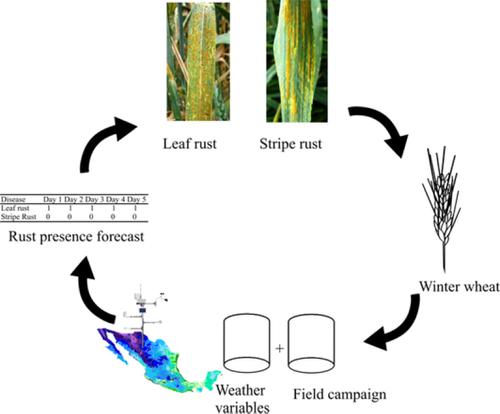当前位置:
X-MOL 学术
›
Meteorol. Appl.
›
论文详情
Our official English website, www.x-mol.net, welcomes your
feedback! (Note: you will need to create a separate account there.)
Weather‐data‐based model: an approach for forecasting leaf and stripe rust on winter wheat
Meteorological Applications ( IF 2.3 ) Pub Date : 2020-03-12 , DOI: 10.1002/met.1896 Victor M. Rodríguez‐Moreno 1 , Alejandro Jiménez‐Lagunes 2 , Juan Estrada‐Avalos 3 , Jorge E. Mauricio‐Ruvalcaba 4 , José S. Padilla‐Ramírez 4
Meteorological Applications ( IF 2.3 ) Pub Date : 2020-03-12 , DOI: 10.1002/met.1896 Victor M. Rodríguez‐Moreno 1 , Alejandro Jiménez‐Lagunes 2 , Juan Estrada‐Avalos 3 , Jorge E. Mauricio‐Ruvalcaba 4 , José S. Padilla‐Ramírez 4
Affiliation

|
Classification and regression trees (CARTs) for data analysis, an hourly weather dataset, and a 3 year field incidence and severity dataset of winter wheat rust were integrated to forecast pathogens’ presence/absence. The field dataset of incidence and severity was collected for three production cycles. Measured records of 88 Automatic Meteorological Stations and the indirect weather dataset generated in the Weather Research and Forecasting environment interpolated to each Automatic Meteorological Station location were analysed in the Python ecosystem. The focal point of the analysis was the severity of the disease. The analysis of direct weather data revealed the association of leaf rust severity with a night temperature of <14.25°C and global radiation of <521.67 W·m–2, while the estimated dataset showed that its severity is better explained by the dew point temperature of <13.7°C and a mean temperature of <19.06°C. The direct dataset also indicated that stripe rust severity was associated with relative humidity of <88.73%, global radiation of <597.39 W·m–2 and dew point temperature of <16.09°C, whereas the estimated data revealed that pathogen severity is better explained by a model composed of a dew point temperature of <14.6°C, night temperature of <20.4°C and a maximum temperature of <27.9°C. The severity and intensity analysis indicated the pathogen's preference for non‐dry ambient conditions and the preference of stripe rust pathogen for humid and warmer temperatures than leaf rust. The weather thresholds of both pathogens, and CART analysis, unveiled that winter wheat rust can be forecasted. This constitutes the foundation of a more efficient extension programme based on the internet of things.
中文翻译:

基于天气数据的模型:一种预测冬小麦叶和条锈病的方法
集成了用于数据分析的分类和回归树(CART),每小时天气数据集以及3年田间小麦锈病发生率和严重性数据集,以预测病原体的存在与否。在三个生产周期中收集了发病率和严重性的现场数据集。在Python生态系统中分析了88个自动气象站的实测记录以及在天气研究和预报环境中内插到每个自动气象站位置的间接天气数据集。分析的重点是疾病的严重程度。直接天气数据分析显示,叶锈病严重程度与夜间温度<14.25°C和全球辐射<521.67 W·m –2的关联,而估算的数据集显示露点温度<13.7°C和平均温度<19.06°C可以更好地说明其严重性。直接数据集还表明,条锈病严重程度与相对湿度<88.73%,整体辐射<597.39 W·m –2有关露点温度<16.09°C,而估计数据表明病原体的严重性可以通过以下模型更好地解释:露点温度<14.6°C,夜间温度<20.4°C和最高温度<27.9 ℃。严重程度和强度分析表明,病原菌偏爱非干燥的环境条件,而条锈病病菌偏爱湿热的温度高于叶锈病。两种病原体的天气阈值和CART分析表明,可以预测冬小麦锈病。这构成了基于物联网的更高效扩展程序的基础。
更新日期:2020-03-12
中文翻译:

基于天气数据的模型:一种预测冬小麦叶和条锈病的方法
集成了用于数据分析的分类和回归树(CART),每小时天气数据集以及3年田间小麦锈病发生率和严重性数据集,以预测病原体的存在与否。在三个生产周期中收集了发病率和严重性的现场数据集。在Python生态系统中分析了88个自动气象站的实测记录以及在天气研究和预报环境中内插到每个自动气象站位置的间接天气数据集。分析的重点是疾病的严重程度。直接天气数据分析显示,叶锈病严重程度与夜间温度<14.25°C和全球辐射<521.67 W·m –2的关联,而估算的数据集显示露点温度<13.7°C和平均温度<19.06°C可以更好地说明其严重性。直接数据集还表明,条锈病严重程度与相对湿度<88.73%,整体辐射<597.39 W·m –2有关露点温度<16.09°C,而估计数据表明病原体的严重性可以通过以下模型更好地解释:露点温度<14.6°C,夜间温度<20.4°C和最高温度<27.9 ℃。严重程度和强度分析表明,病原菌偏爱非干燥的环境条件,而条锈病病菌偏爱湿热的温度高于叶锈病。两种病原体的天气阈值和CART分析表明,可以预测冬小麦锈病。这构成了基于物联网的更高效扩展程序的基础。











































 京公网安备 11010802027423号
京公网安备 11010802027423号